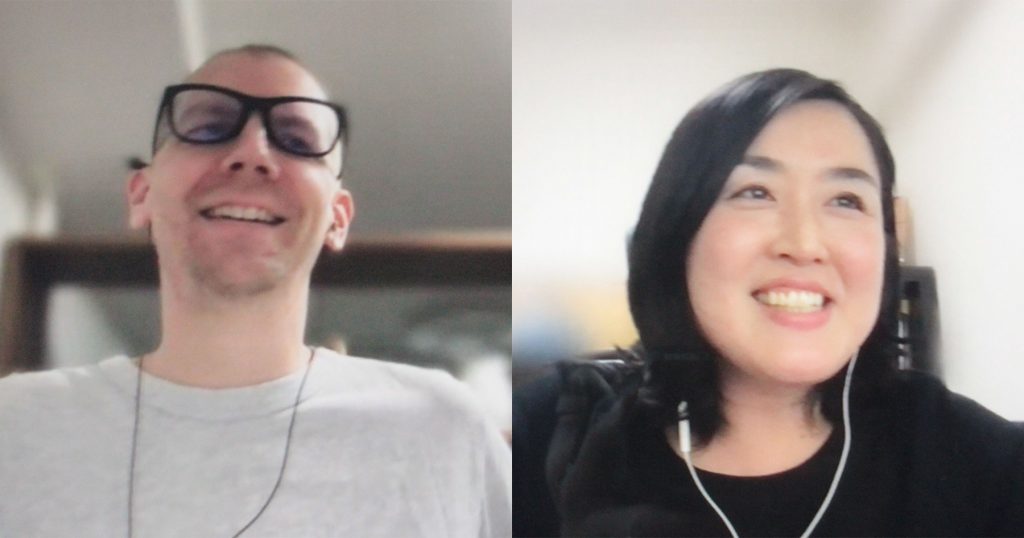(One day, the Contents Team was talking…)
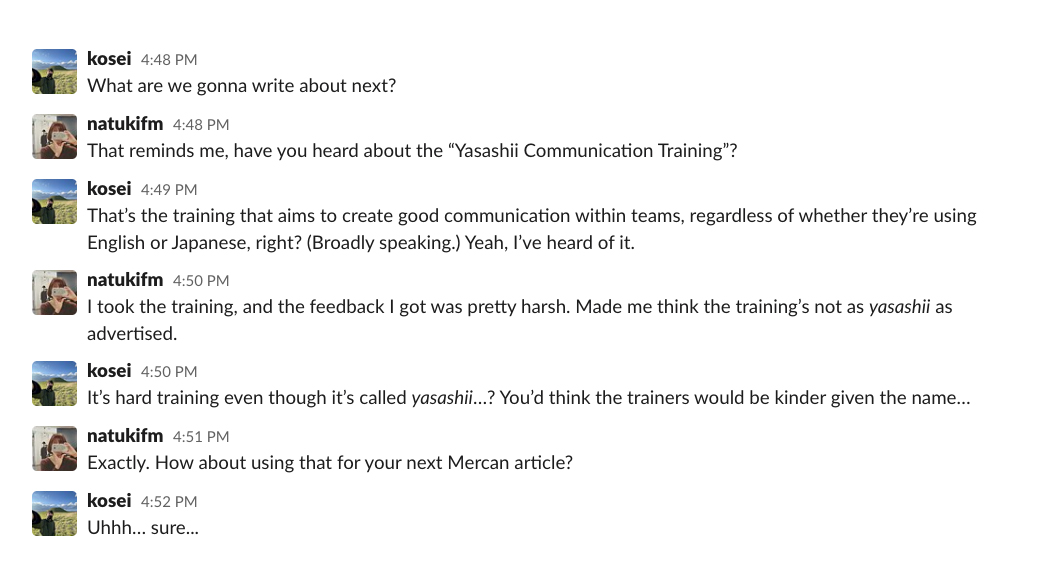
This time, we have @kosei going straight to the source to find out how yasashii (easy and kind) Mercari’s “Yasashii Communication Training” really is. I hope that @natukifm’s story hasn’t got you spooked, @kosei…
In this Interview
-

Masayo Wilson (@Maz)
LET Japanese Language Trainer/Coach & Yasashii Japanese Trainer. After working at a foreign international distribution company, Maz began working as a Japanese trainer in 2013. She has been in charge of Japanese education for overseas exchange students, businesspeople, and future nurses and caregivers. She joined Mercari as a Japanese trainer in July 2018, developing Mercari’s Japanese language program and speaking test. She also leads the Yasashii Communication in-house training program as a Yasashii Japanese trainer. -

John VanSomeren (@JohnV)
LET English Language Trainer/Coach & Yasashii English Trainer/IR Officer. John has worked as an in-house business English trainer since 2010. In the past, he worked at the former Zynga Japan, Inc. and DeNA Co., Ltd. He joined Mercari in March 2018. In addition to his work as an English coach, John leads the Yasashii Communication program. His responsibilities expanded in January 2021, to include work on the IR Team as an IR Officer, bolstering communication with investors.
What is “Yasashii Communication Training” in the first place?
“Yasashii Communication Training” is a training program which the Language Education Team (LET) provides to teams using both English and Japanese. The basic principles of Yasashii Communication are:
●A language culture where speakers “meet each other halfway”
●Teams with members who are not proficient in one language or the other stay attentive to each other’s difficulties and struggles, searching for better communication methods together
●Focus on the essence of communication, not Japanese or English language skill
●In meetings, Japanese-speaking members can speak Japanese and English-speaking members can speak English, but only using words that all members understand
In other words, all language learners share an understanding of what is difficult for learners of the other language, regardless of whether they’re speaking English or Japanese. By combining that with word choices that are easy to understand, we make communication more effective overall. Check out the past articles below for an overview.
A Hands-on Look at “Yasashii Communication Training”
*We purposely mixed Japanese and English to make it feel like an actual training session as much as possible.
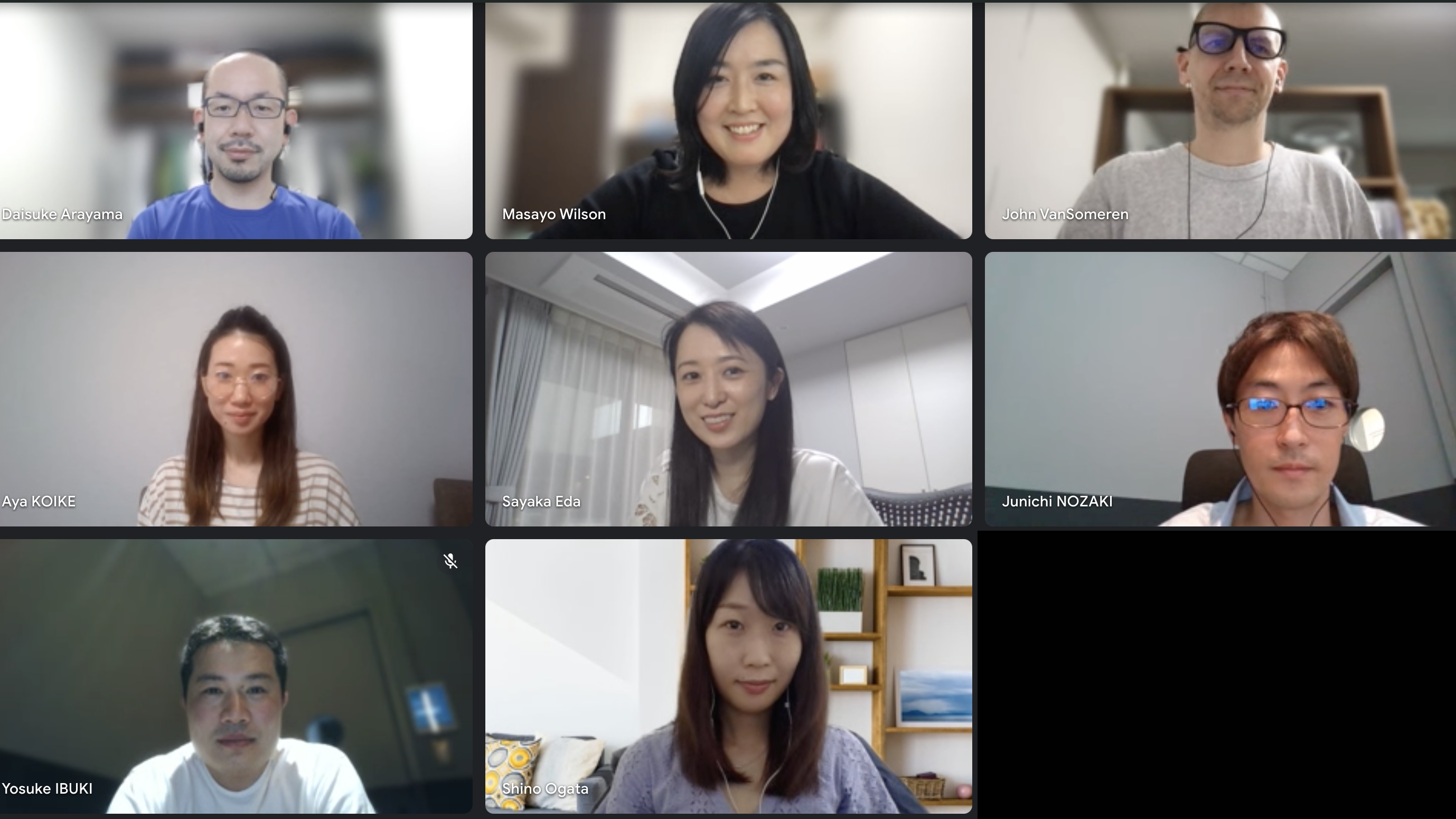 The trainers were @Maz and @JohnV, with members of the IR Team participating.
The trainers were @Maz and @JohnV, with members of the IR Team participating.
They started by once again sharing the purpose of the training.
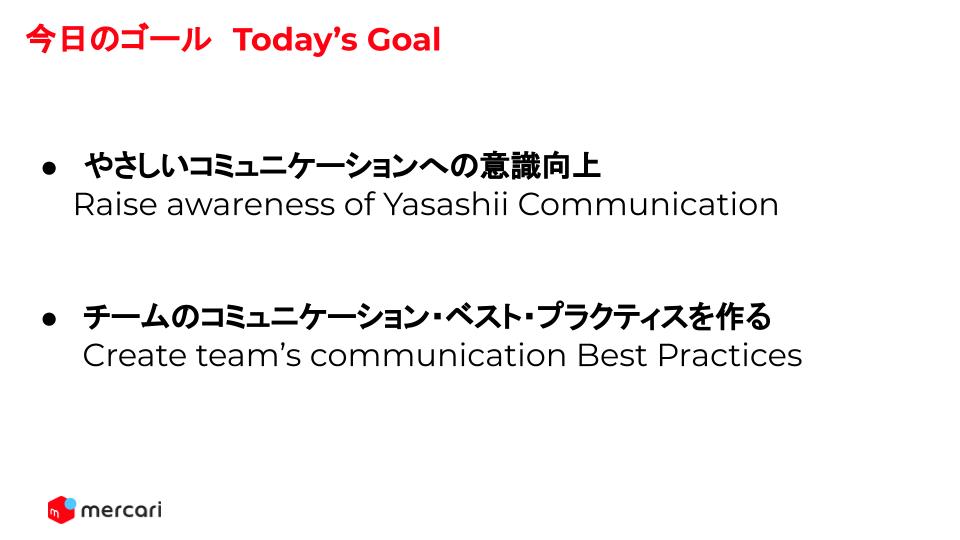
Then we immediately went to the mini practice exercise.
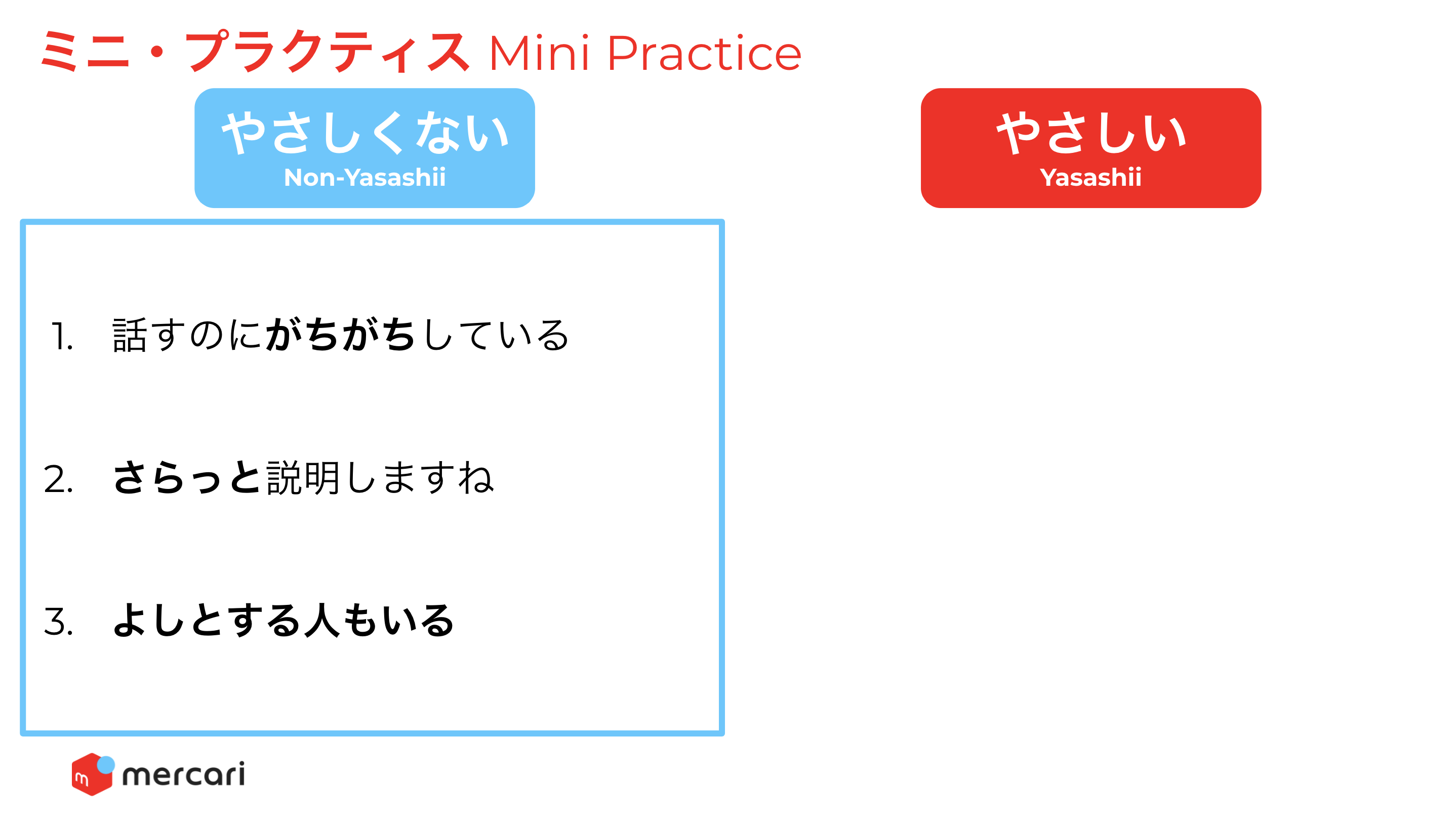
Participant:For saratto setsumei (quick explanation), I could say kanketsu ni setsumei (concise explanation).
@JohnV:That sounds even more difficult to understand. (lol)
@Maz: Right. You’re only making it harder to understand.
Participant:What about temijika ni (short and sweet) then?
@Maz:What do you think, @JohnV?
@JohnV: Yeah… I don’t understand that.
Participant:gachigachi (uptight) → kinchou shiteiru (nervous) saratto (quickly) → kantan ni (easily) yoshi to suru hito mo iru (some of them will settle for it) → ii to kangaeru hito mo iru (some think it’s good)
@Maz:Nice! What do you think, @JohnV?
@JohnV:Yeah,Better!!
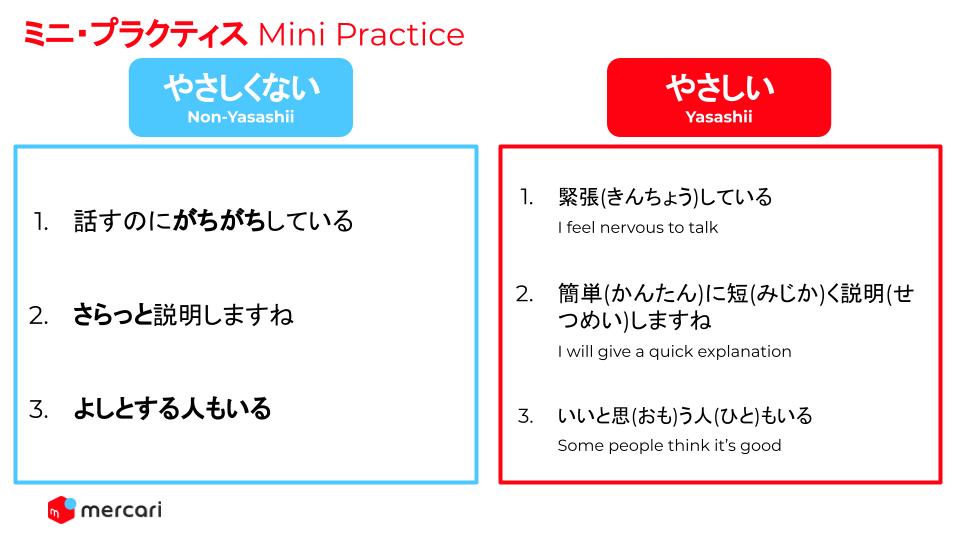
What about “non-Yasashii” English?
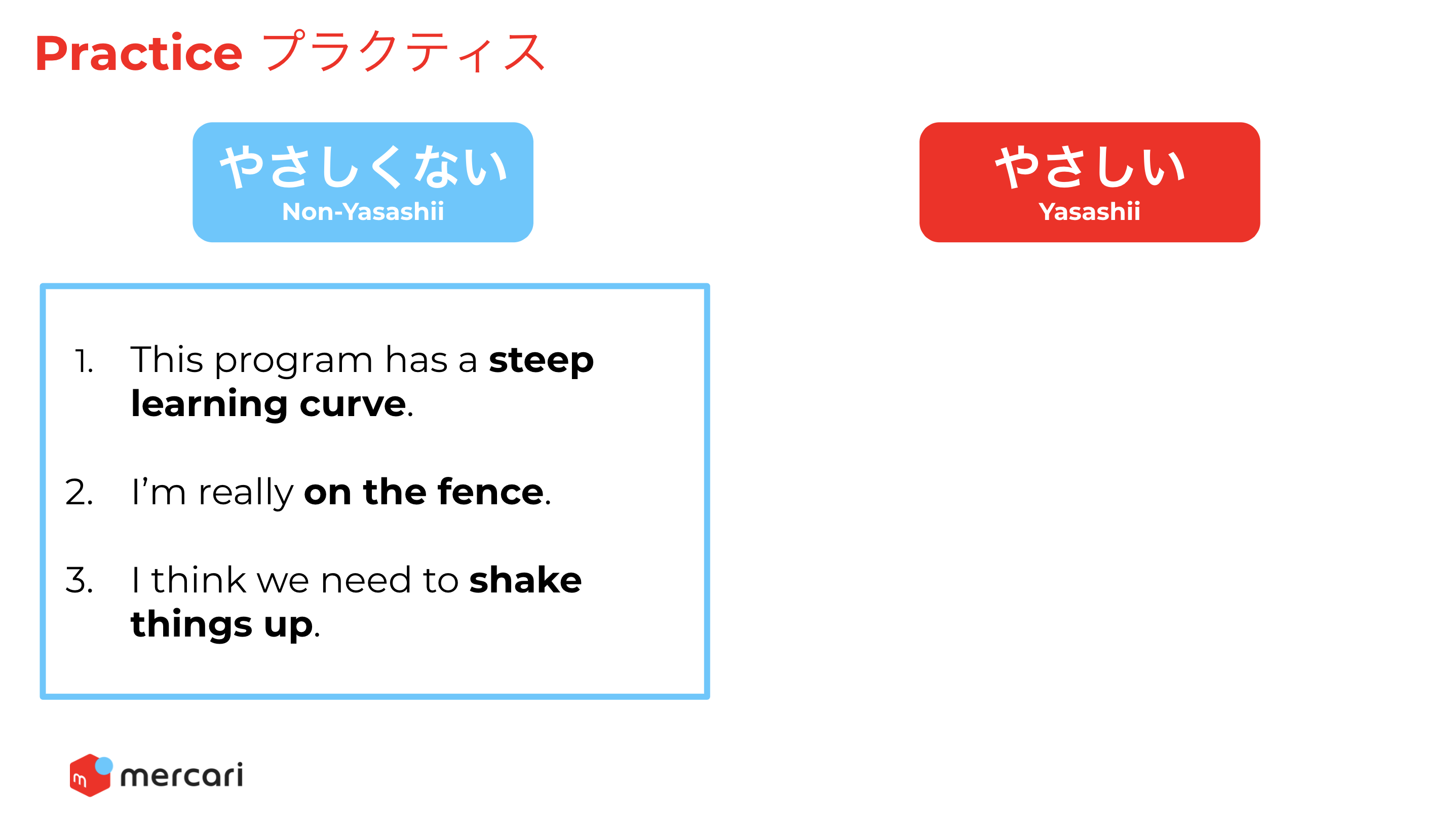
@JohnV:Do you know what any of these phrases mean? Any guesses?
@Maz:Even though I’ve seen them countless times, I can’t remember what they mean. (laughs) How about everyone else?
Participant: I don’t really understand any of these.
Participant:I get the feeling that “shake things up” means something like “change completely,” yeah?
@JohnV:Nice!!
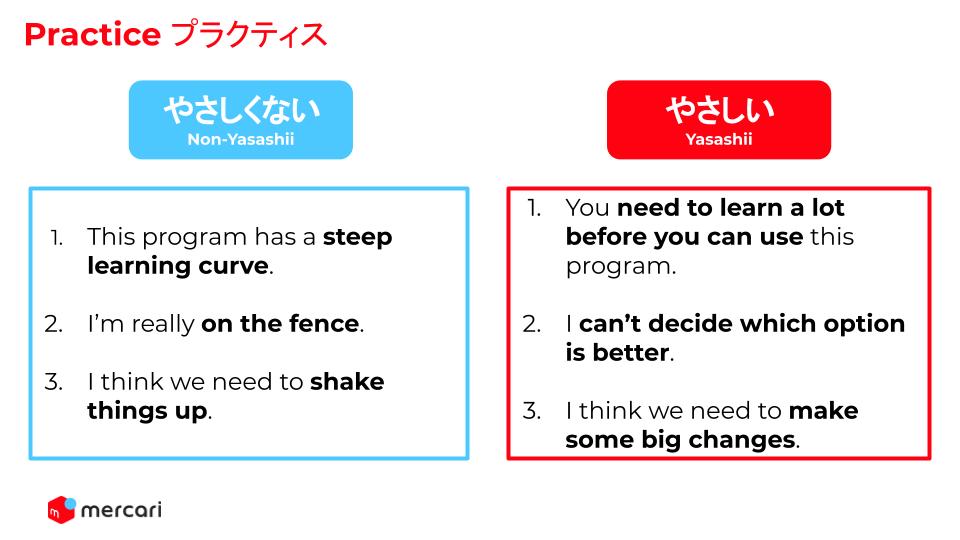
After that, we started the team discussion.
We started to discuss what the IR Team could do to be better known by Mercari members. After the discussion, among only the IR members, Maz and JohnV talked with them to give some feedback.
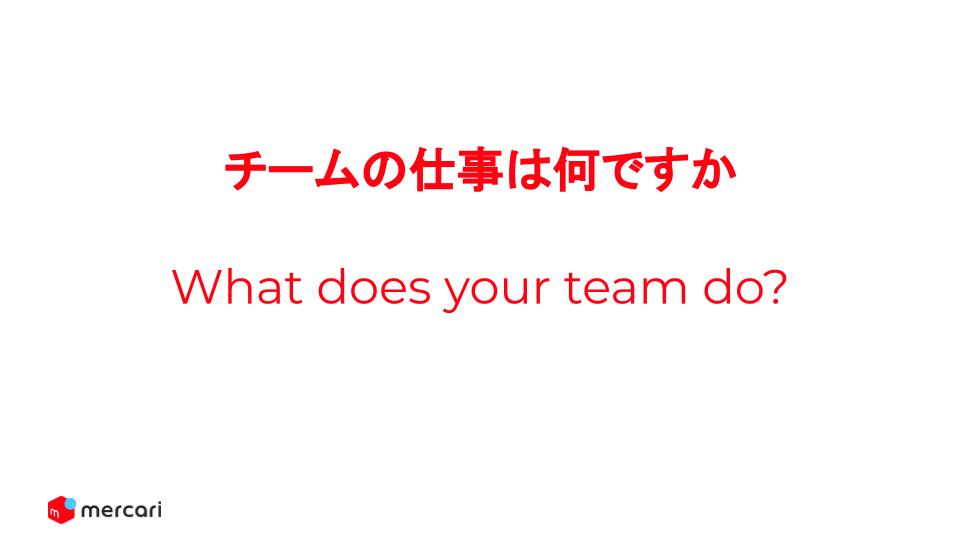
@Maz:Okay, time’s up. Was there anything you especially tried to focus on this time?
Participant: I have a habit of speaking in long sentences, so I tried to keep it short.
@Maz:Interesting. If you’re the type that always speaks in long sentences, it’s definitely good to cut them into smaller sentences with a single message each. Anything you noticed listening to discussion, @JohnV?
@JohnV:I could follow about 70% because I understand the topic and context, but maybe 30% is not very clear.
@Maz:Hmmm, interesting. @JohnV’s Japanese level is not that low, so I wonder what the cause was. What I noticed listening to this discussion was the number of words using complex kanji (Chinese character) compounds. For example, noudouteki (active) or rikai sokushin (promote understanding).
@JohnV:Yeah, I have no idea what those mean. (laughs)
@Maz:@JohnV is from an English-speaking country, and they say kanji is the most difficult part of studying Japanese for people with an English background. This is why experts say that using natively Japanese, non-kanji expressions makes your Japanese easier to understand. There are many substitutions you can make. For example:
ichirei → hitotsu no rei (one example)
meikaku → hakkiri wakarimasu (clearly understand)
noudouteki ni (actively) → watashi kara aite ni ______ shimasu (I will (do this action to) them)
You can also ask listeners directly whether they understood what you said during a meeting. This can help clarify the remaining 30% that @JohnV didn’t understand.
Next, we talked about “communication best practices” within the team.
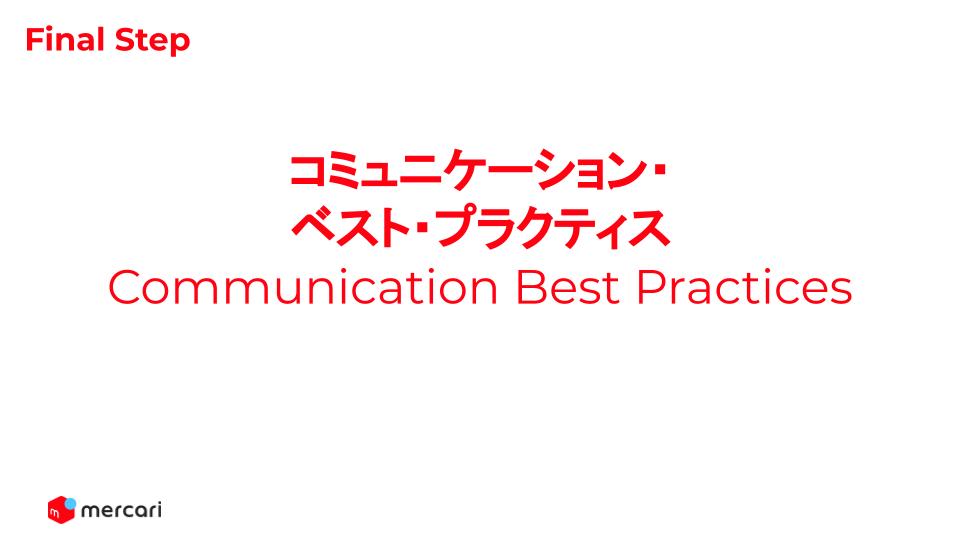
Again, after the team discussed their ideas about communication best practices, the LET members gave their feedback on the discussion.
@Maz:@JohnV, do you have any thoughts listening to the team’s discussion?
@JohnV:I feel it was clearer than the earlier discussion. So yeah, things improved!
@Maz:Members were placing more focus on substituting words than during the previous activity. But it’s still difficult to know how much someone like @JohnV is actually understanding. That’s why it’s important to create a safe space where members can ask questions when they don’t understand some of the language during discussion. This is true whether members are speaking English or Japanese. You need to create an atmosphere within the team that allows members to ask @JohnV to repeat himself if they don’t understand some of the English he’s using, for example.
And the training continues…
If you thought the training was over, it’s not! Let’s move on to the next step.
We’re going to actually try using the best practices you developed through this training to receive more feedback on those practices. Continuous communication and improvements are vital to ensuring your communication is yasashii.
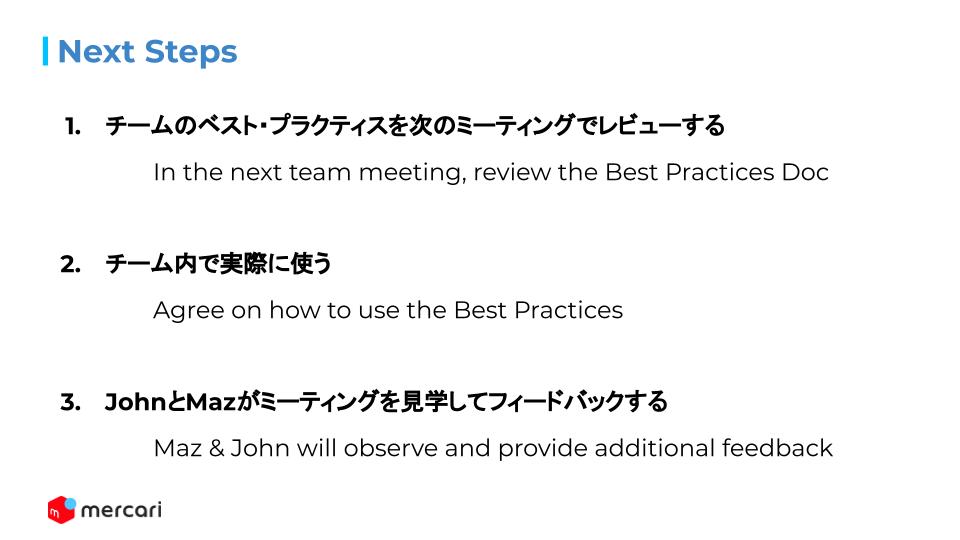
Talking to @Maz and @JohnV After the Training
ーThank you again for letting me join the training. There was lots that I found eye-opening, even as an observer. I think from now on, I want to talk in shorter sentences and break down difficult kanji compounds into substitutes when I talk. Incidentally, why did you decide to conduct this training for the IR Team?
@JohnV:The IR Team is made up of both English and Japanese speakers. Some of the members are basically bilingual, while some of the other members speak either English or Japanese at an intermediate level. We chose them for this training because we thought it would be perfect to help the IR Team find their best practices for conducting effective and inclusive meetings and discussions (=“communication best practices”).
@Maz:This was a somewhat rare case though, since @JohnV was participating as both LET’s Yasashii English Trainer and as a member of the IR Team.
@JohnV:It was a really interesting experience. I had a chance to explain the basic points of Yasashii Communication to the IR Team beforehand, and I was convinced this training would be useful to them given the efforts they’ve been making to create more inclusive communication within the team. As to why I became a member of the IR Team in the first place, that’s a story for another day…
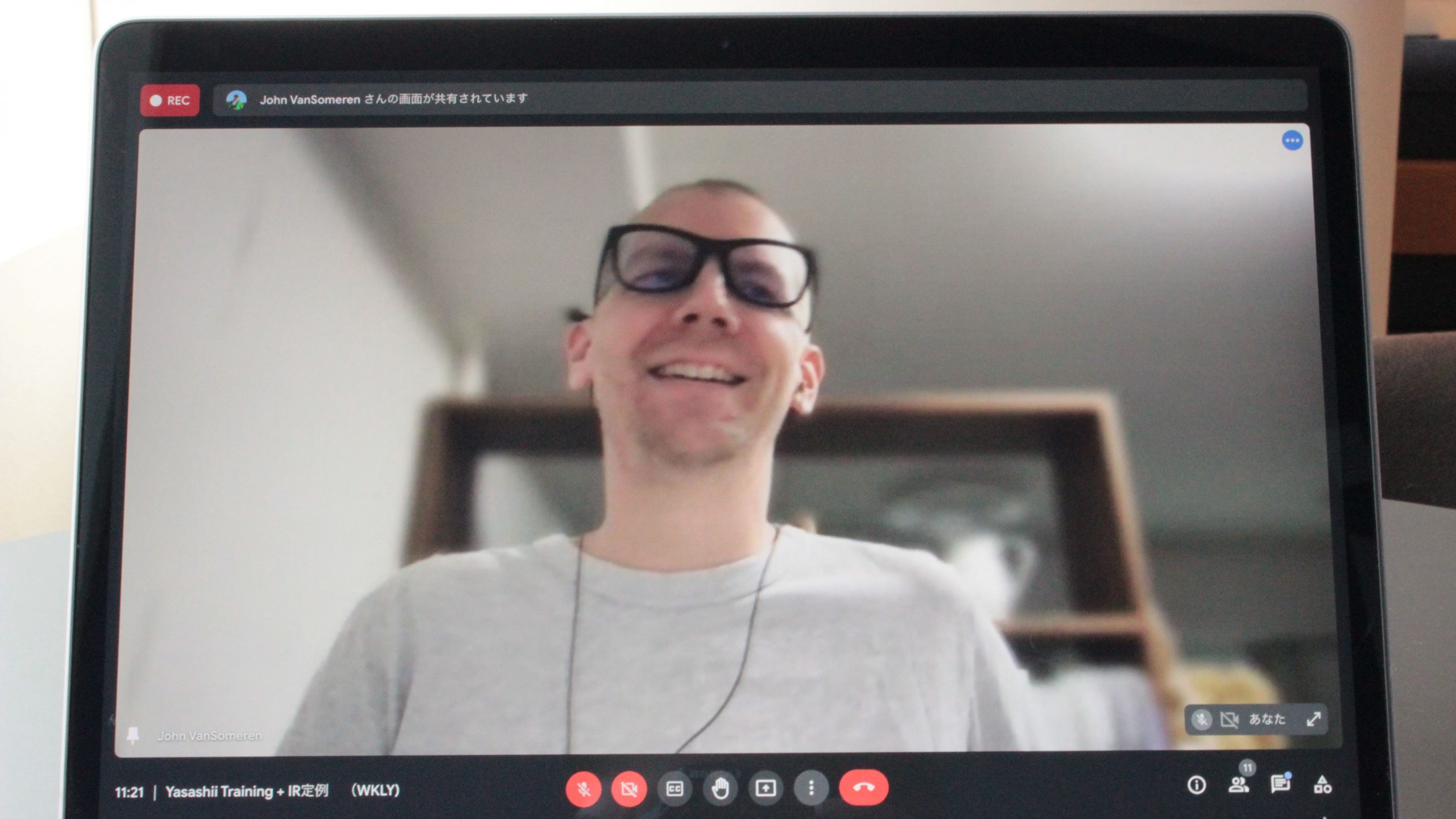 John VanSomeren (@JohnV)
John VanSomeren (@JohnV)
What Does “Meeting Halfway” Mean to the Trainers?
ーI thought that during the training, the way @JohnV was explaining his ideas was a bit harsh and could impact his future relationship with the other IR members. Was there anything you tried to pay attention to in particular as a trainer this time?
@JohnV:My natural communication style is to always communicate things very directly. When you are facilitating a training, it’s important to strike a good balance between giving proper feedback and encouraging the participants. This time, we had our regular meeting right after the training, so I was particularly careful about that.
ーBut definitely during this training, I noticed members thanking me after I asked them to explain Japanese I didn’t understand. That really left an impression on me.
@Maz:It might not have looked like @JohnV was “meeting them halfway” during the training, but you often see him following up during all kinds of meetings to make sure that everyone understands what’s going on when the English isn’t necessarily yasashii. He’s also making a list of “non-Yasashii English” phrases.
ーWhat’s this “non-Yasashii English” list?
@JohnV:I started making this list quite a while ago. Basically, I just wrote down examples of “non-Yasashii English” from the meetings and events I attended. I started because I wanted to have a list of examples I could use during the training. What I realized, though, is that making the list itself was good training for me. It’s great practice for native English speakers or proficient speakers to accurately understand which words and phrases are difficult for English language learners. This is what “meeting halfway” means to me.
I’m still adding to the list. I may end up selecting the “top 3 non-Yasashii English speakers” based on the list. (laughs)
ーYikes. (laughs) But I can see how these small examples of helping speakers “meet halfway” are important as a trainer.
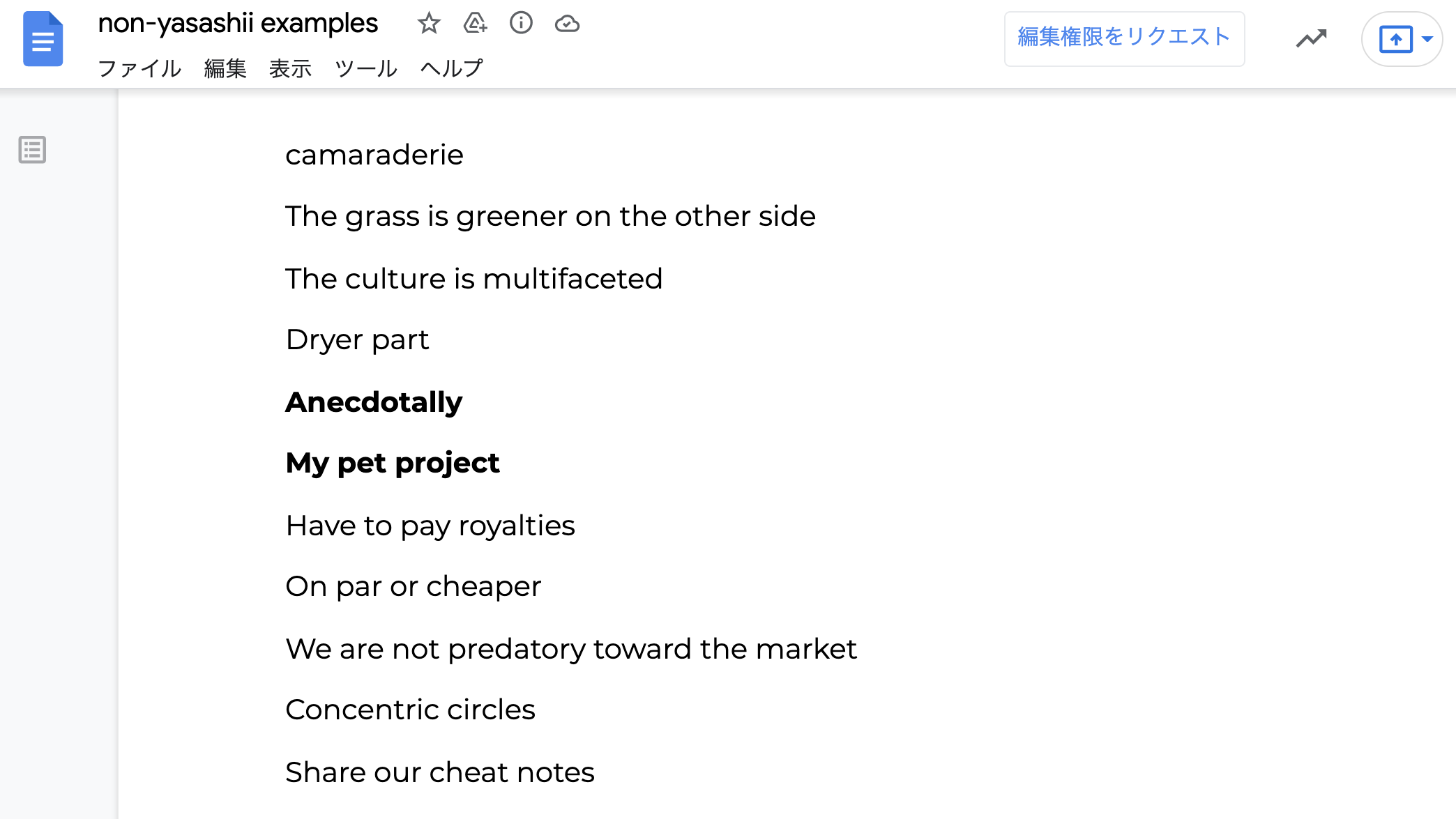
Where Are We Now, After 2 Years of Yasashii Communication
ーYou’ve been working on Yasashii Communication for two years now, @Maz. What changes have you seen or felt within the company?
@Maz:Yeah, it’s already been two years… The first time we held the training was August 2019.
A lot has changed, actually. For example, there was one internal event a while ago where the MC had inserted Yasashii English and Yasashii Japanese warning slides into the presentation without LET even saying anything. I think it’s amazing to see that kind of mindset developing among members.
Mercari members are especially willing to go above and beyond, without fear of making a mistake. Our members will do whatever it takes to get the message across because they feel comfortable making mistakes, and at the same time, our company culture recognizes diverse English and Japanese ability levels, with no need to speak perfect Japanese or English.
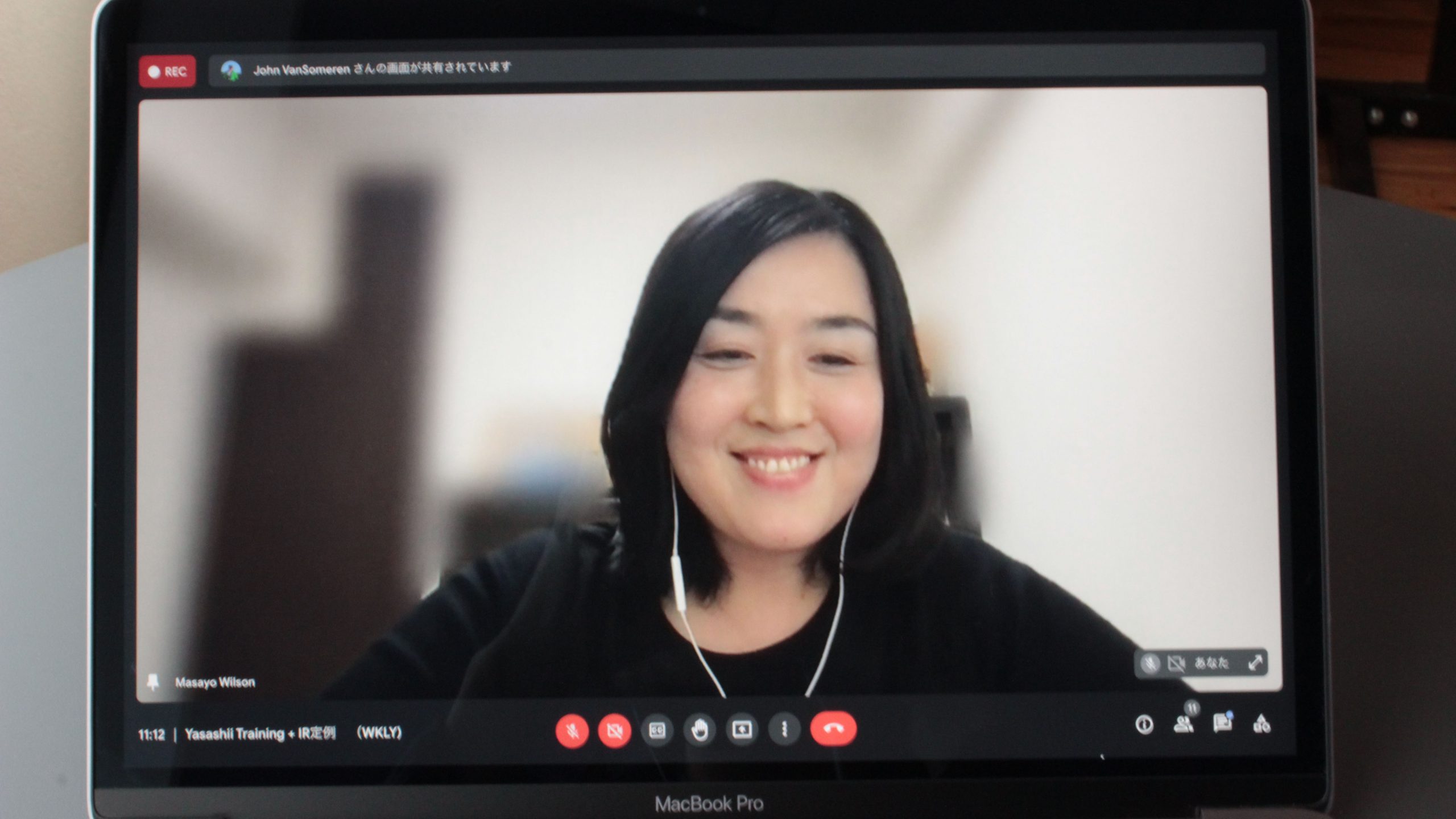 Masayo Wilson (@Maz)
Masayo Wilson (@Maz)
ーIt lowers the barrier to entry, when members don’t expect perfect language ability from each other. How about you, @JohnV?
@JohnV:Members mutually understand where they struggle with English or Japanese, creating that empathy between many of our members. I also feel that most of our members understand that perfect language usage is not the goal; ultimately, communication is the goal.
ーI feel like Mercari members have really internalized Yasashii Communication thanks to the robust internal training you provide, but how yasashii is our communication really?
@JohnV:We’ve held the training for more than 30 teams now, with over 400 total participants.
@Maz:We don’t only have them take the training either; we also conduct both pre- and post-surveys of participants. These surveys look at two metrics: “Do you show consideration for others?” and “Do others show consideration for you?” We measure these 2–3 weeks after the training to see if there has been any improvement.
ーWhen you consider that Mercari Group has more than 1,800 members, there’s clearly still room for improvement when it comes to participant numbers. What are some possible causes and solutions for the low number overall?
@JohnV:Until recently, LET had been carefully targeting those teams where Yasashii Communication could help solve immediate challenges within the team. We found teams that were facing communication difficulties and then customized the training to accurately address that team’s communication needs. But this method takes a lot of time and effort.
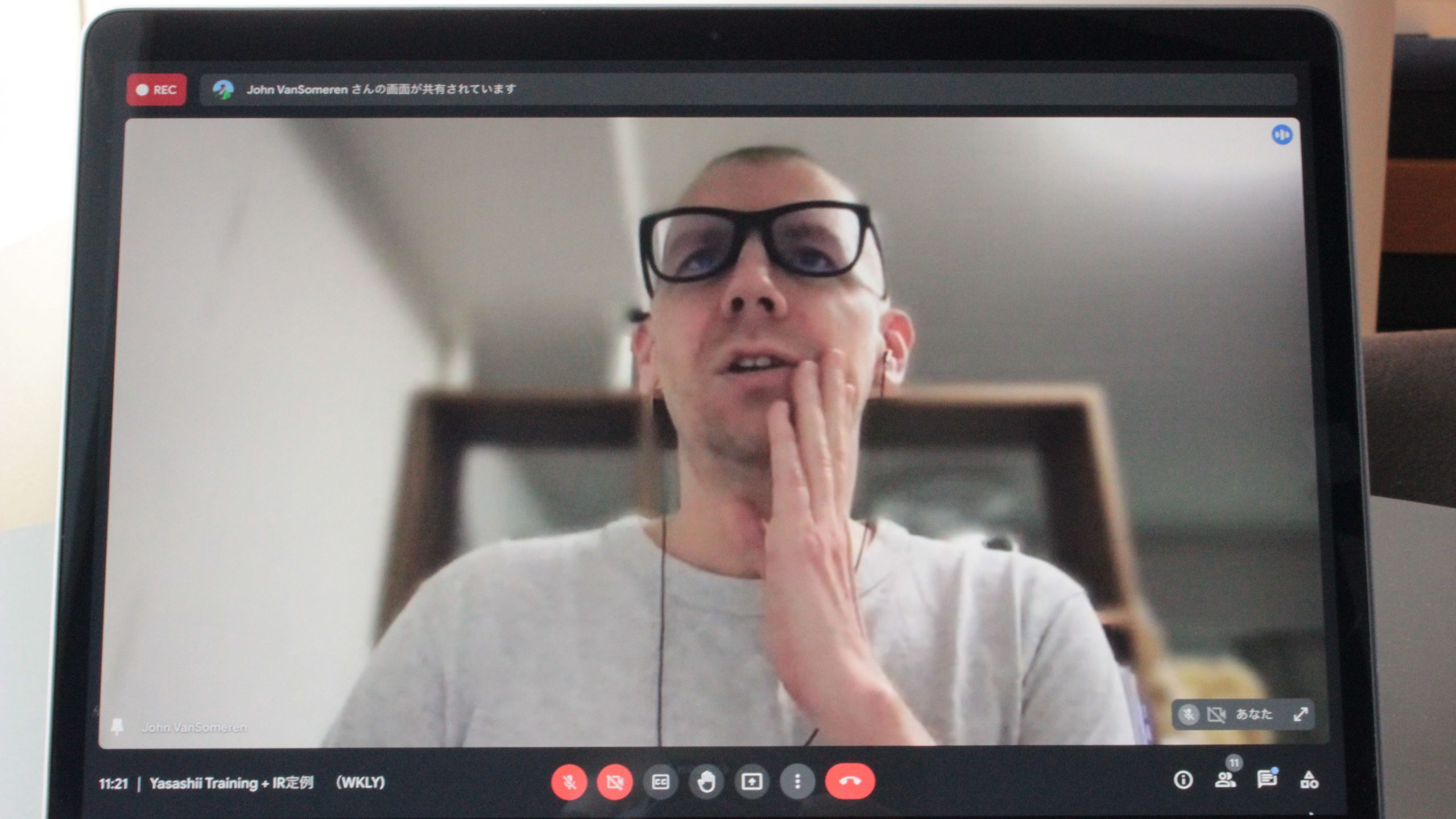
@Maz:Right. We plan to figure out a way to expand the training to a wider range of teams and have more teams take the training. This should help create a better understanding of the importance of Yasashii Communication within Mercari.
Making a More Yasashii World
ーWhat are your plans for “Yasashii Communication Training” going forward?
@Maz:We will continue to hold the training internally, and at the same time, we plan to make a series of trainings, holding case study-based study sessions at other companies with similar language and communication issues. We recently held the first of these, actually. Given the response we’ve received so far, it’s clear that many companies want to create this kind of Yasashii Communication mindset.
And Japanese itself remains a high barrier for non-native speakers working in Japanese. The same goes for native Japanese speakers working in English. We want Yasashii Communication to help lower that language barrier and create a more accommodating Japan where it’s easier for everyone to work and live. That’s why we want to help train new trainers at other companies.
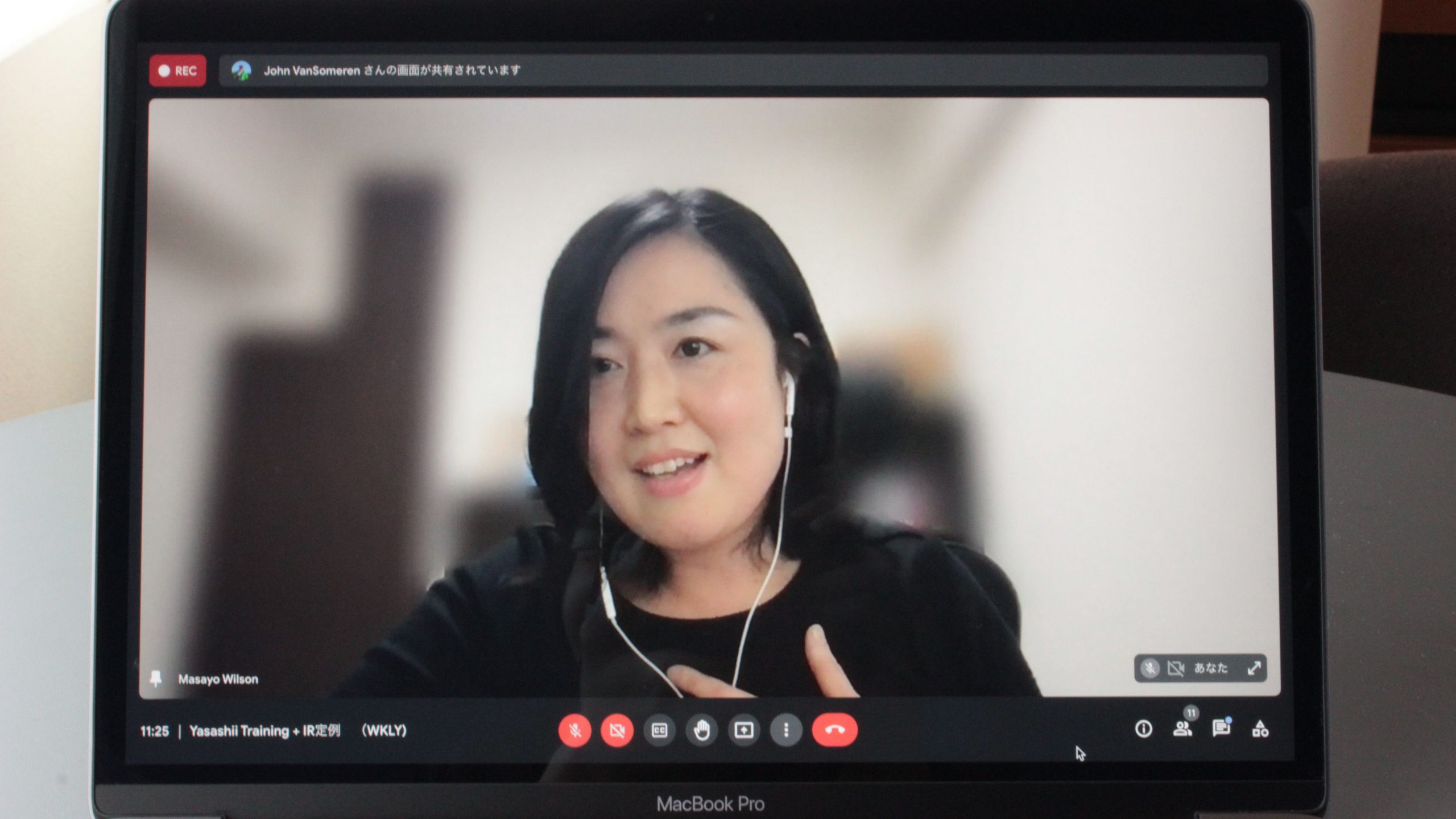
@JohnV:As @Maz said, we want Yasashii Communication to be more widely recognized and used both within Mercari and outside the company. We have high hopes.
The Tables Have Turned!
@Maz:So this article is asking “whether Yasashii Communication is really yasashii,” right?
@kosei:Yes, exactly. I heard from some of the other Contents Team members that the training is actually quite difficult…
@Maz:What did you think about the training after actually observing it today, @kosei?
@kosei:I was really impressed by how brusquely you and @JohnV spoke.
@Maz:What do you mean by “brusquely?”
@kosei:I guess “brusquely” isn’t very yasashii. (laughs) For example, during your explanation at the start of the training. You said, “LET Team will explain. We will ask you questions sometimes. Please actively participate.” I think usually, we might combine some of these ideas into single sentences, but you purposely made them very short. At the same time, asking members to “actively participate” maybe presupposes that people won’t actively participate.
You did a good job of praising their ideas when trying to come up with Yasashii Japanese and thanking members who pointed out when the Japanese was not yasashii. I guess those were my impressions.
Personally, I thought the training was plenty yasashii. (laughs)
@Maz:That’s a good point. We should maybe say something like,” We would appreciate your active participation,” or something similar to give them the option to participate less, if they prefer. That might be why people felt the training was difficult in the first place!
@kosei:Japanese expressions so often include implicit or ambiguous information. There are times where those expressions are the accommodating choice, as well as times where they are not. It might be that the native Japanese members who took the training felt that doing everything you can to reduce those ambiguous elements made the expressions less accommodating for the listener.
@Maz:But conversely, if you were told those same things in English, you might be thankful that the speaker was so clear about what they wanted you to do, rather than muddying the meaning. Imagining the situation from the other person’s perspective allows you to consider the most easy-to-understand way to express your message and select your words and phrases carefully.
@kosei: I totally get it. In a broader sense, there might be a cultural bias towards English as a language—that the expressions are just too direct—but it really does feel that way.
Still, I understand that while implicit information might be one type of yasashii, the more yasashii choice is using language that is easy-to-understand, even if it sounds a bit harsh.
@Maz: Exactly. And as you pointed out, when people say “thank you” for considering their communication needs and express gratitude to the people they work with, it creates psychological safety for all members and makes Yasashii Communication more commonplace within the team.
@kosei:Yasashii Communication creates more Yasashii Communication. It seems obvious, but I can imagine how having Yasashii Communication be fully adopted by members can help improve the amount and quality of individual speakers’ output. It seems like it would make the training more effective, too.
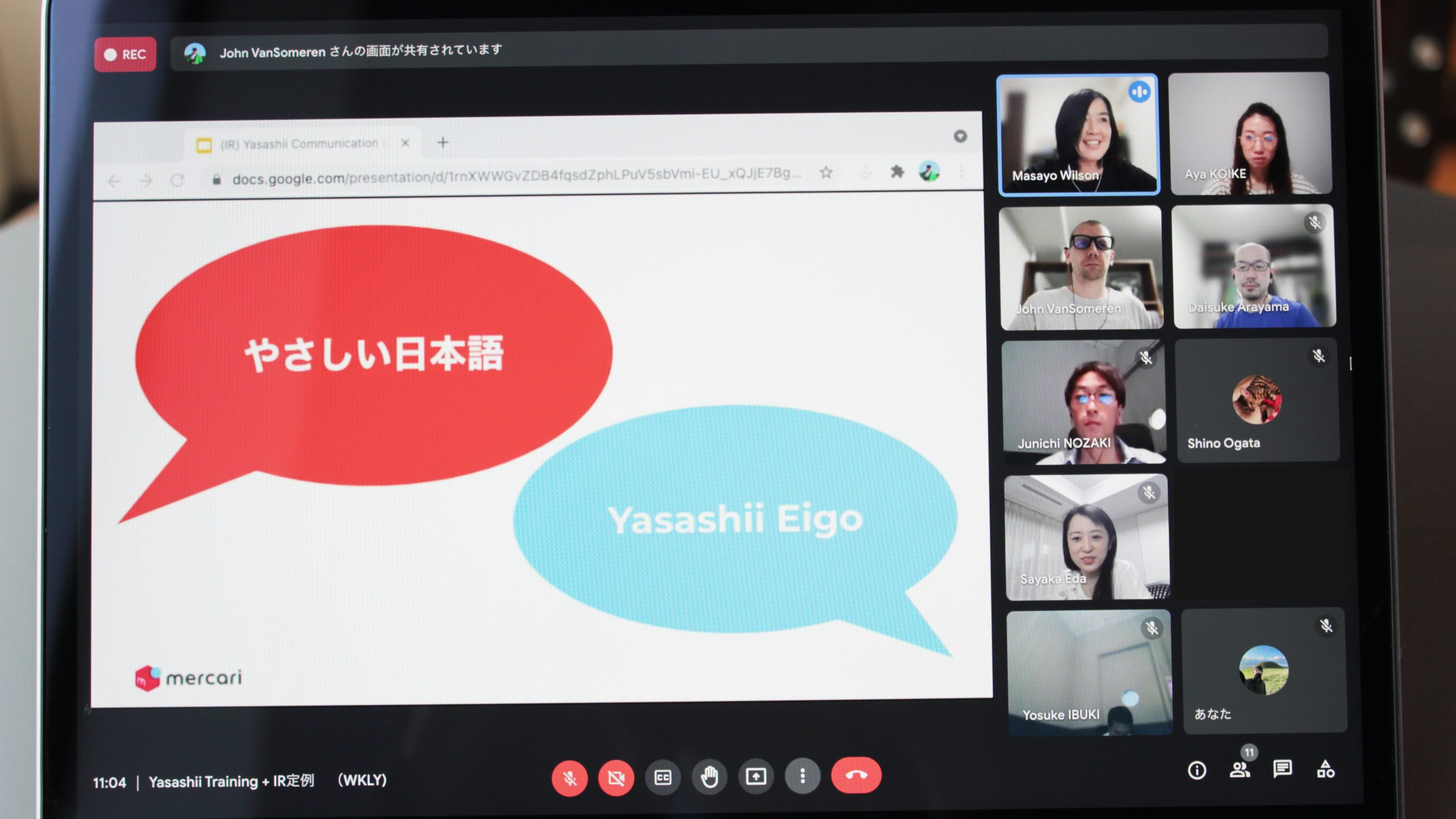
ーBeing told that what you’ve said is too direct ultimately leads to more Yasashii Communication. That’s why this training has the reputation it does. “It’s difficult to make communication easy.”
Incidentally, when I asked the other Contents Team members what words they had been told were “not yasashii,” they said it was Totsugeki Tonari no Bangohan, the Japanese TV show… But I guess that all depends on the cultural background and age of the listener… (laughs) At any rate, it seems the only thing “not yasashii” about this training was the participants’ word choice.


